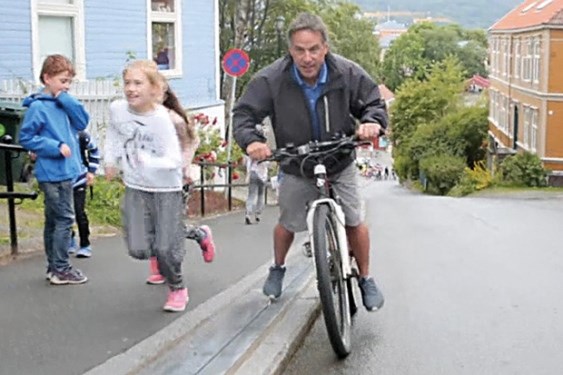Although there’ll be more hurdles ahead, the City of North Vancouver is inching forward with a plan to bring in an urban bike lift.
At Monday’s council meeting it was decided in a 4-3 vote that the CNV would use $60,000 appropriated from its general reserve fund to pay for a study to look at an urban bike lift’s feasibility.
Councillors were voting on where funds for the study would come from, but the discussion quickly turned to larger issues pertaining to bike use, safety, and urban development in North Vancouver.
Mayor Darrell Mussatto, who first proposed the idea after being inspired by a similar bike lift in Trondheim, Norway, was an enthusiastic supporter.
“I think that moving forward with this – staff have done a tremendous amount of work to keep it at this number – it will give us a better position to make a decision should we want to go ahead with that,” he said.
An urban bike lift, in theory, operates similar to a ski lift. A cyclist puts his or her foot onto a metallic plate that gently pushes them, along with their bike, uphill.
Councillors first voted on studying the project’s feasibility back in October, when it also passed in a narrow 4-3 vote.
Coun. Pam Bookham, who voted against the bike lift study last time, was against using the city’s reserves to pay for the feasibility study.
“It’s not the $60,000,” she said. “If we’re generally in favour of a project, spending $60,000 to get the kind of preliminary information that we would need to pursue that kind of project would make sense.”
Bookham said “it’s the larger figure” that concerns her.
“We have to ask ourselves, ‘Where can we get best value in our community for cyclists for the amount of money that would be expended if we were to implement this specific plan?’”
According to the website for the “CycloCable,” the urban bike lift design the city of Trondheim uses, the system would cost around $2,300 to $3,100 per metre to install. The general reserve fund for the CNV, which pays for community enhancement projects, sits at $59 million.
City staff have previously identified several areas where a bike lift could be installed, including the Spirit Trail along East 4th and West Keith Road.
Coun. Don Bell said the cost-benefit of implementing a bike lift would not be worth it and that he didn’t support “this particular aspect of the cycling program.” He also said that money should be used to improve roads for cyclists, not for adding bike lifts.
“I think that that kind of money they were talking about, which went into the millions, could be better spent making the roadways safer for cyclists rather than trying to go into this kind of a lift,” he said.
Coun. Craig Keating was one of the strongest proponents of the urban bike lift. He said the answer to making commutes for bikers easier and safer wasn’t by building them on longer routes, but by investing in something new.
He said that by not giving the urban bike lift a chance “we’re effectively saying is that on a policy level, we’re forgoing an opportunity to deal with the fact that we live in a hilly place.”
He said that funding the urban bike lift study could be a “potential opportunity to overcome that and re-engage people in cycling.”



